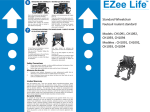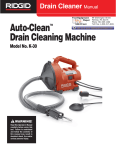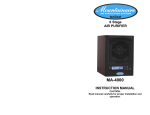Download 190/195 Tilt Shower Commode User Manual
Transcript
..................................................................................................................... 190/195 Tilt Shower Commode User Manual Limited Warranty: EZee Life products carry a two year warranty against manufacturing defects, faulty materials and workmanship only. Any alterations, misuse, abuse, or accidental damage voids this warranty. EZee Life reserves the right to replace or repair any part that has become defective. The warranty does not extend to consequential costs resulting from the fault or defect of the product: freight and travel costs, loss of earnings, or other expenses that one may incur. Warranty is valid for the original purchaser only and the original receipt must be presented before any warranty options are considered. Please also be prepared to provide the date of purchase and serial number. EZee Life™ Products 34 Futurity Gate, Unit # 15 Concord Ontario L4K 1S6 Specifications: Frame Material – Aluminum Tilt Range – 20° Weight – 36 lbs (#190) 38 lbs (#195) Rear wheels – 5” standard or optional 24” Front Casters – 5” Seat Width – 18” (#190) 20” (#195) Seat Depth – 17” Standard Seat Heights – 23.5” or 24.5” (adjustable) Foot Rest Hanger Angle – 60° Foot Rest Length – 14” to 20” (Infinite adjustment) Back Height – 18” Arm Height – 11” (from seat) Arm Length – 13” Arm Pad Length – 9 1/2” Weight Capacity – 250 lbs (#190), 300 lbs (#195) Features: Molded seat, back & arm rest pads Commode hole insert Adjustable molded headrest Flip back arms Locking swivel casters Adjustable height swing away footrests Composite flip up foot plates Side release seat belt Calf Strap Single lever tilt release Strong tubular aluminum frame Adjustable removable anti-tippers 2 Assembly Instructions 1. Slide seat belt loops (1) onto each side of backrest (2) posts. 2. Insert two back support posts (1) into seat frame (2) and tighten two hand wheels (3). 3. Insert four caster stems (1) into holes (2) in the four corners of the bottom of the seat frame (3). 4. Set the seat height by aligning the caster stem holes (1) with the desired adjustment holes (2) in the frame and inserting the locking pin (3) to secure the caster. Note: There are only three height settings with standard casters. For added height use the optional extended casters DO NOT align the top hole in the caster stem with the bottom hole in the frame. The top hole on the caster stem should only be aligned with the top hole in the frame. The bottom hole in the caster stem can be aligned with either hole in the commode frame. 5. Insert the anti-tippers (1) into the two antitipper receiver tubes (2) located at the rear of the seat frame above the casters. Ensure the push pins (3) have popped through the set receiver holes. 3 6. The adjustment is made by simply depressing the anti-tipper push pin (1), sliding the inner anti-tipper tube (2) to the desired length, aligning the push pin with the closest adjustment hole (3) and allowing it to pop through. (The anti-tippers should be as close to the floor as possible without catching on doorway thresholds, changes in floor levels or other obstacles.) 7. To attach the foot rest (1) to the commode lower the foot rest pivot plug (2) into the top of the front seat frame (3) with the foot plate (4) off to the side of the commode. Then swing the foot rest to the forward position where it will lock in place. 8. The foot plate height can be adjusted by loosening the footrest clamp (1), sliding the the foot plate extension tube (2) up or down inside the foot rest hanger tube (3) and re-tightening the clamp. DO NOT extend the footplates past the MAX line (4) stamped into the foot plate extension tubes. The MAX line should not be visible. 9. From the back of the commode slide the commode pail into the pail support channels (1) located on the bottom of the seat pan (2). 10. Install the adjustable head rest (1) by inserting and vertical support tube (2) into the headrest bracket (3) mounted on the commode push bar and then insert the horizontal support tube (4) through the end bracket (5) of the vertical tube (2). 4 Adjustments Headrest – The headrest on this commode is referred to as an “X” headrest and the smaller end of the “X” is at the bottom to support the neck where it meets the back of the skull. The arms of this style of headrest can be flexed in or out as needed by simply pulling them apart or squeezing them together to provide more control or more freedom as needed. The angle of the headrest can also be adjusted by loosening the three allen screws (1) holding the horizontal support tube (2), pivoting the head rest to the desired position and re-tightening the allen screws. Anti-Tippers – The anti- tippers are required to prevent the commode from tipping backwards when it is tilted back or when the user is self-propelling with the optional 24” wheels. They can be flipped up or removed when necessary to clear obstacles but should be in place as often as possible to prevent accidental tipping of the commode. Tilt Mechanism Cables – The cables (1) that allow the chair to tilt may over time stretch. This is normal and can be adjusted by loosing the lock nut (2), turning the adjustment screw (3) counter-clockwise and re-tightening the lock nut. When adjusted properly the distance between the strut release lever (5) and the cable anchor (6) should be 1”. If the chair angle cannot be changed when the tilt lever (4) is depressed the cause is usually stretched cables. If the chair will not lock at any angle the cables are likely adjusted too tight. 5 Adjustments cont'd Footplate Adjustment – Proper footplate adjustment is required for comfort and reduction of pressure points. If the footplates are positioned too high pressure is increased on the buttock area; if they are too low, pressure is increased on the the backs of the legs just above the knees and the feet are left dangling. See item 8 on page 4 for adjustment procedure. Operating Instructions Arms – The arms of the commode can be flipped up and back to aid in transfers or access by caregivers for bathing. The arms will stay raised when raised all the way. When doing a side transfer to or from the commode only the arm on the side the transfer is being done on should be raised. Seat Belt – The seat belt supplied with the commode is known as a side release seat belt. To undo the buckle simply depress both release tabs at once and pull the two sides apart. To do up the seat belt insert insert the prongs into the receiver until they click position. into Foot Rests – The foot rests can be removed by pushing the release lever (1) swinging the footrests out to the side, or into the middle, and lifting straight up. To replace the foot rests, lower the foot rest pivot plug (2) into the commode seat frame holes (3) from the side on the center of the seat and swing the footrests to the front until they lock into position. Headrest – The headrest can be removed to aid in transfers by loosening the Headrest clamp on the commode push bar. 6 Operating Instructions cont'd Tilting – The tilt feature of the 190 tilt shower commode can be used for comfort, for those users who have balance control problems or may squirm in the seat too much to be safe when the seat is level. This shower commode also features an anterior tilt (tilts forward) to aid in transferring into and out of the seat. To activate the tilt mechanism the caregiver grasps the commode push bar and squeezes the release lever (1). When the release lever is squeezed, two gas struts mounted on the side frames that hold the seat in position are released and the seat can be positioned at the angle wanted. Letting the release lever out will lock the seat at the angle set. Important: When the release lever is squeezed the seat will move freely. The caregiver must have the push bar of the commode firmly grasped when activating the release lever to prevent the seat from pitching forward possibly injuring the user. The user should always wear the provided seat belt for safety while sitting in this commode. Casters – The 180 and 185 shower commodes come standard with 4 locking 5” swivel casters that allow the commode to be turn a full circle in its own length and be pushed in any direction required. This is particularly important feature when the commode has to be used in areas where there isn't much room for manoeuvring. To lock the casters the caregiver uses their steps on the lock lever (1). To release the wheel lock the caregiver pushes down on the release lever (2) with their foot. When the casters are in the locked position the swivel feature also locks for safety. 7 Optional 24” Wheels The optional 24” wheels allow the user to be able to self propel the shower commode and provide a level of independence. The 24” wheels are equipped with contoured hand rims for better grip, solid maintenance free lightly treaded tires to ease propulsion and quick release axles to allow to wheels to be removed and replaced easily without tools. Installation and Removal - To install the optional 24” wheels there are 2 simple steps: 1. Insert the quick release axles through the center of the wheels by pushing the quick release button (1) in the center of the wheel. 2. Holding the wheel by the spokes, once again push the quick release button (1) with your thumb and pass the portion of the axle protruding through the back of the wheel through the axle housing (2) until the axle protrudes all the way through (3). 3. Ensure the wheel is securely attached to the commode by trying to remove the wheel without depressing the quick release button. 4. Push to quick release button and pull on the wheel to remove. Note: The wheel locks must be in the off position to install or remove the wheels. Wheel Locks - When your commode is equipped with 24” wheels the wheel lock system for those wheels is the same as found on a manual wheelchair. The front casters will still be the standard 5” casters with foot activated wheel locks. To engage the wheel locks (1) push the brake levers (2) forward until they lock. To release, pull the brake levers backwards. 8 Wheel Lock Installation for 24” Wheels – When the optional 24” wheels are ordered with your commode the push to lock hand brakes will need to be installed to the side frame seat rail. The wheel lock assemblies are clamped to the seat rail (1) using a double clamp that simultaneously tightens onto the seat rail and wheel lock mounting bar. 1) Position the double clamp (2) onto the seat rail and wheel lock mounting bar (3) and tighten loosely so that the assembly will hold together but can still be adjusted. 2) Position the knurled brake bar (4) horizontally in front of the tire and slide the entire assembly along the seat rail as needed until the distance from the front of the wheel lock mounting bar to the front of the seat rail is approximately 8.5 cm (3 3/8”). 3) Tighten up the double clamp (2) enough to test the wheel lock and ensure the brake bar (4) indents into the tire far enough to prevent the wheel from turning when wheel lock is engaged. 4) If needed, the double clamp (2) can be loosened slightly and positioned a littler farther from or closer to the tire to ensure good contact with the tire while still being fairly easy to operate. 5) Tighten double clamp (2) and repeat this procedure for the opposite side of the commode. Note: The double clamps can be used on either side of the commode but the wheel lock assemblies come in left hand and right hand configurations. The wheel locks and the assembly procedure will not work if the the right hand wheel lock is mounted on the left side of the commode and vice versa. 9 Safety Information Never operate the tilt mechanism without having a firm grip on the commode push bar. The gas struts used to aid in tilting the commode need to be controlled while changing the tilt angle to prevent the chair from pitching forward Ensure back rest is securely attached before using. To avoid tipping, DO NOT attempt to reach objects if you have to move forward in the seat. To avoid tipping, DO NOT attempt to reach objects if you have to pick them up from the floor by reaching down between your knees. To avoid tipping, DO NOT lean over the top of the back upholstery to reach objects behind you, as this may cause the commode chair to tip over. To avoid tipping, DO NOT shift your weight or sitting position toward the direction you are reaching. DO NOT attempt to stop, or slow, a moving transport chair with wheel locks. Wheel locks are not brakes. DO NOT climb, go up or down ramps or traverse slopes greater than 5 degrees (1:12 grade). Travel up and down slopes and inclines. DO NOT travel across inclines. Use caution on slippery surfaces. DO NOT transfer into, or out of, the shower commode chair on slippery floors. Ensure wheel locks are engaged and wheels are positioned outward before transferring into or out of the shower commode. DO NOT stand on foot plates or seat. Always use the supplied seat belt for safety. Always have the arms flipped down if the user has upper body stability problems. Always use supplied anti-tippers for users who are known for rocking in their seats. DO NOT leave users unattended in the shower chair. DO NOT overload this transport chair. The weight capacity is 300 pounds including the user and any things they may be carrying. 10 Inspection Items Ensure the commode chair rolls straight (no excessive drag or pull to one side). Inspect the seat, back and arms for tears and/or damage. Inspect for any loose or broken hardware or parts. Inspect for cracked, broken or loose wheels. Ensure the hand brakes are easy to engage and prevent the wheels from turning. Cleaning Instructions EZee Life commodes can be cleaned with most commercial cleaning products. Do not use abrasives on the foam seat and back pads. We recommend cleaning the surfaces of the commode and attachments with a solution made from a mild detergent (dish soap, etc.) to remove organic materials. Once cleaned the commode can be disinfected but wiping it down with a 5% (1 cup bleach to 1 gallon water) solution of bleach and water. Allow the bleach solution to remain on the surfaces for 3 to 5 and minutes, then rinse thoroughly with clear water. Note: Bleach reacts with ammonia and organic matter (feces) causing gases that can irritate the eyes and lungs. Use in a ventilated area and avoid contact with other chemicals and organic matter. 11





















